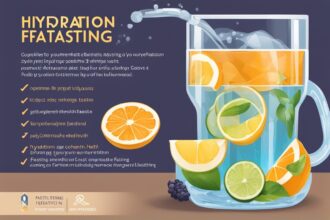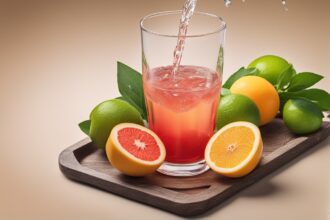Hey there, fasting enthusiasts! If you’re diving into the world of fasting—whether it’s intermittent fasting, water fasting, or a religious fast like Ramadan—you’ve probably wondered how to keep your body hydrated without breaking your fast. Hydration during fasting is a critical yet often overlooked topic in any fasting guide. Water and electrolytes play a huge role in how you feel during a fast, impacting everything from energy levels to mental clarity. In this comprehensive post, we’ll explore why hydration matters, how fasting affects your body’s water balance, and practical ways to stay hydrated without compromising your fasting goals. Let’s sip into the science and strategies with a conversational yet informed approach, ensuring you’ve got all the tools to fast safely and effectively.
Why Hydration Matters in Your Fasting Journey
When you’re fasting, your body isn’t just skipping meals—it’s undergoing a metabolic shift. You’re not consuming food or, in some cases, drinks, which means your usual sources of hydration (like water-rich fruits or soups) are out of the picture. About 20–30% of our daily water intake comes from food, so fasting can quickly tip the scales toward dehydration if you’re not mindful (Institute of Medicine, 2005). Dehydration during fasting can lead to fatigue, headaches, dizziness, and even more severe issues like electrolyte imbalances. Staying hydrated isn’t just about comfort; it’s about supporting your body’s natural detox processes and maintaining vital functions like temperature regulation and circulation. As part of this fasting guide, understanding hydration is your first step to a successful fast.
How Fasting Impacts Your Body’s Water Balance
Fasting changes how your body handles water and electrolytes. When you stop eating, your body taps into glycogen stores in your liver and muscles for energy. Glycogen is stored with water, so as it’s used up, you lose water weight—often why people notice a quick drop on the scale in the first few days of fasting (Kerndt et al., 1982). This water loss can be deceptive, making you think you’re hydrated when you’re not. Additionally, without regular food intake, you’re missing out on electrolytes like sodium, potassium, and magnesium, which are crucial for fluid balance. Research shows that prolonged fasting without proper hydration can increase the risk of dehydration-related symptoms, especially in hot climates or during physical activity (Sawka et al., 2007). So, while fasting can have benefits like improved insulin sensitivity, neglecting hydration can counteract those gains.
Practical Tips to Stay Hydrated While Fasting
Now that we’ve covered the ‘why,’ let’s get into the ‘how’ of hydration in this fasting guide. The good news? You don’t need to break your fast to stay hydrated if you’re strategic. Here are actionable tips to keep your water levels topped up, tailored for various fasting protocols like intermittent fasting or dry fasting.
- Drink During Non-fasting Windows: If you’re on an intermittent fasting plan like 16:8, maximize your eating window to drink plenty of water. Aim for at least 8–10 cups (2–2.5 liters) during this time to prep your body for the fasting hours.
- Start with Water: Break your fast with a glass of water before eating. This helps rehydrate your system gently and prevents overeating, which can strain digestion after a fast.
- Monitor Your Urine: A simple way to check hydration is by looking at your urine color. Pale yellow means you’re good; dark yellow or amber signals you need more fluids.
- Avoid Overloading at Once: Don’t chug gallons of water in one go—it can overwhelm your system. Sip steadily throughout your allowed hydration periods.
Electrolytes: The Unsung Heroes of Fasting Hydration
Water alone isn’t always enough, especially during extended fasts. Electrolytes—minerals like sodium, potassium, and magnesium—help regulate fluid balance, nerve function, and muscle activity. When fasting, especially for more than 24 hours, electrolyte levels can drop due to reduced intake and increased excretion through urine (Popkin et al., 2010). Low electrolytes can cause symptoms like muscle cramps, fatigue, or even heart palpitations in extreme cases. So, how do you manage this during a fast? If your fasting rules allow, consider adding a pinch of high-quality sea salt to your water during eating windows or consuming an electrolyte supplement with zero calories. Studies suggest that maintaining electrolyte balance during fasting can significantly reduce discomfort and improve adherence (Institute of Medicine, 2005).
What to Drink (and Avoid) During Fasting Periods
One of the most common questions in any fasting guide is, “What can I drink while fasting?” The answer depends on your fasting type, but let’s break it down with some clear dos and don’ts to maintain hydration without breaking your fast.
- Water: Plain water is your best friend. It’s calorie-free, universally accepted in all fasting types (except dry fasting), and essential for hydration.
- Black Coffee or Tea: If you’re doing intermittent fasting, unsweetened black coffee or tea can be okay during fasting windows. They have minimal calories and can help curb hunger, though caffeine may dehydrate some people, so balance with extra water (Sawka et al., 2007).
- Electrolyte Drinks (Zero-Calorie): For longer fasts, look for sugar-free electrolyte powders or tablets if your protocol allows. Check labels to ensure no hidden sweeteners break ketosis or fasting benefits.
- Avoid Sugary Drinks: Sodas, juices, or even “diet” drinks with artificial sweeteners can spike insulin or add calories, breaking most fasts. Stick to pure, simple options.
- Skip Alcohol: Alcohol dehydrates you and can interfere with fasting benefits like autophagy. Save it for non-fasting days and rehydrate afterward.
Special Considerations for Different Fasting Types
Not all fasts are created equal, and hydration strategies vary depending on your approach. As a comprehensive fasting guide, let’s touch on a few common fasting styles. For intermittent fasting (like 16:8 or 5:2), you’ve got eating windows to hydrate and replenish electrolytes, so it’s easier to manage. Water fasting, where only water is consumed for 24–72 hours, requires pre-fast hydration and careful monitoring to avoid over-drinking, which can lead to hyponatremia (low blood sodium) (Hew-Butler et al., 2017). Dry fasting, often practiced for spiritual reasons, involves no water or food for a set period—here, hydration before and after is critical, as even mild dehydration can pose risks (Burke & Deakin, 2010). Lastly, during religious fasts like Ramadan, where no food or water is consumed from dawn to dusk, focus on hydrating foods (like watermelon) and ample water during non-fasting hours. Tailor your hydration plan to your fasting style for the best results.
In wrapping up this fasting guide, remember that hydration isn’t just a side note—it’s the foundation of a safe and effective fast. Whether you’re fasting for weight loss, spiritual reasons, or health benefits, keeping your body’s water and electrolyte balance in check can make or break your experience. By planning ahead, sipping strategically, and listening to your body’s signals, you can avoid the pitfalls of dehydration and enjoy the full benefits of fasting. Got questions or personal hydration tips for fasting? Drop them in the comments—I’d love to hear how you stay refreshed on your fasting journey!
References
- Burke, L. M., & Deakin, V. (2010). Clinical sports nutrition (4th ed.). McGraw-Hill Education.
- Hew-Butler, T., Rosner, M. H., Fowkes-Godek, S., et al. (2017). Statement of the Third International Exercise-Associated Hyponatremia Consensus Development Conference. Clinical Journal of Sport Medicine, 27(5), 471-479.
- Institute of Medicine. (2005). Dietary Reference Intakes for Water, Potassium, Sodium, Chloride, and Sulfate. National Academies Press.
- Kerndt, P. R., Naughton, J. L., Driscoll, C. E., & Loxterkamp, D. A. (1982). Fasting: The history, pathophysiology and complications. Western Journal of Medicine, 137(5), 379-399.
- Popkin, B. M., D’Anci, K. E., & Rosenberg, I. H. (2010). Water, hydration, and health. Nutrition Reviews, 68(8), 439-458.
- Sawka, M. N., Burke, L. M., Eichner, E. R., et al. (2007). American College of Sports Medicine position stand: Exercise and fluid replacement. Medicine & Science in Sports & Exercise, 39(2), 377-390.






